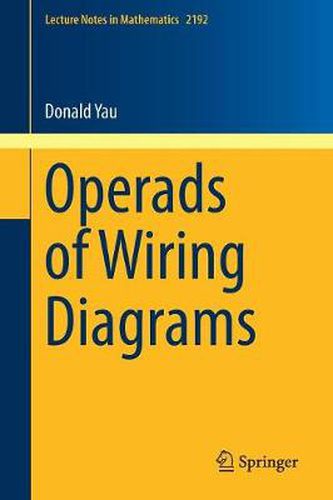Readings Newsletter
Become a Readings Member to make your shopping experience even easier.
Sign in or sign up for free!
You’re not far away from qualifying for FREE standard shipping within Australia
You’ve qualified for FREE standard shipping within Australia
The cart is loading…






This title is printed to order. This book may have been self-published. If so, we cannot guarantee the quality of the content. In the main most books will have gone through the editing process however some may not. We therefore suggest that you be aware of this before ordering this book. If in doubt check either the author or publisher’s details as we are unable to accept any returns unless they are faulty. Please contact us if you have any questions.
Wiring diagrams form a kind of graphical language that describes operations or processes with multiple inputs and outputs, and shows how such operations are wired together to form a larger and more complex operation. This monograph presents a comprehensive study of the combinatorial structure of the various operads of wiring diagrams, their algebras, and the relationships between these operads.
The book proves finite presentation theorems for operads of wiring diagrams as well as their algebras. These theorems describe the operad in terms of just a few operadic generators and a small number of generating relations. The author further explores recent trends in the application of operad theory to wiring diagrams and related structures, including finite presentations for the propagator algebra, the algebra of discrete systems, the algebra of open dynamical systems, and the relational algebra. A partial verification of David Spivak’s conjecture regarding the quotient-freeness of the relational algebra is also provided. In the final part, the author constructs operad maps between the various operads of wiring diagrams and identifies their images.
Assuming only basic knowledge of algebra, combinatorics, and set theory, this book is aimed at advanced undergraduate and graduate students as well as researchers working in operad theory and its applications. Numerous illustrations, examples, and practice exercises are included, making this a self-contained volume suitable for self-study.
$9.00 standard shipping within Australia
FREE standard shipping within Australia for orders over $100.00
Express & International shipping calculated at checkout
This title is printed to order. This book may have been self-published. If so, we cannot guarantee the quality of the content. In the main most books will have gone through the editing process however some may not. We therefore suggest that you be aware of this before ordering this book. If in doubt check either the author or publisher’s details as we are unable to accept any returns unless they are faulty. Please contact us if you have any questions.
Wiring diagrams form a kind of graphical language that describes operations or processes with multiple inputs and outputs, and shows how such operations are wired together to form a larger and more complex operation. This monograph presents a comprehensive study of the combinatorial structure of the various operads of wiring diagrams, their algebras, and the relationships between these operads.
The book proves finite presentation theorems for operads of wiring diagrams as well as their algebras. These theorems describe the operad in terms of just a few operadic generators and a small number of generating relations. The author further explores recent trends in the application of operad theory to wiring diagrams and related structures, including finite presentations for the propagator algebra, the algebra of discrete systems, the algebra of open dynamical systems, and the relational algebra. A partial verification of David Spivak’s conjecture regarding the quotient-freeness of the relational algebra is also provided. In the final part, the author constructs operad maps between the various operads of wiring diagrams and identifies their images.
Assuming only basic knowledge of algebra, combinatorics, and set theory, this book is aimed at advanced undergraduate and graduate students as well as researchers working in operad theory and its applications. Numerous illustrations, examples, and practice exercises are included, making this a self-contained volume suitable for self-study.